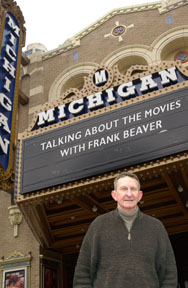
This web page is part of the Michigan Today Archive. To see this story in its original context, click here.
November 2006
Talking about movies: "Movie Magic"
By Frank Beaver
Two of this fall's most popular films are about stage magicians: "The Illusionist" and "The Prestige." Each is a stylish period piece set at the turn of the 20th Century and built around the idea that everyone loves the illusions created by masterful magicians—even as the magicians are creating the illusions to satisfy private needs and preoccupations. A number of people have asked me why two period films about stage magic should appear at virtually the same time—and both draw large audiences. Those questions made me reflect on the innate, long-standing connections between magical illusion and moving pictures. At its most elemental level, any moving picture can be regarded as "magic." Because the human eye retains an image for a fraction of a second longer than it actually appears (persistence of vision), a progressive series of still photographs—or frames of film—can be rapidly projected before the eye and appear to be in a state of motion. Optical magic! One article on audience responses to the first projected motion pictures in the 1890's described the effect as "delirium." Another said that there was "wild applause" at changing screen images which showed people and vehicles in a state of locomotion. A third said that audiences sitting down front at an early theater actually lurched back when ocean waves broke on the screen. These responses are not unlike those of the turn-of-the-century theater audiences seen in "The Illusionist" and "The Prestige," reacting to stage magic. Motion pictures had arrived at the very same moment to provide a very different kind of illusory trickery, but one no less engaging. On a historical note, the motion picture from its earliest days was recognized as a suitable medium for the display of magic tricks. Georges Méliès, a 19th-century Parisian theater owner and stage magician, had earned a reputation as a producer of theatrical spectacles that contained all manner of visual illusions. In 1896, Méliès bought a motion picture projector so that he could show short movie scenes as a part of his theater programs. Shortly afterwards he built a camera that allowed him to make his own short films. Méliès also discovered the optical possibilities of double-exposure. In "The Man With Two Heads" a man's head-to-toe body image is seen in one part of the screen frame while in another part filmgoers saw the man's head in a large close-up. The film had been run back in the camera and then re-exposed to acquire the two images. The same technique was used in "Cinderella" for the sudden appearances of the fairy godmother. In his most famous film "A Trip to the Moon" (1902), Méliès employed stop-action trickery, double-exposure, and frame animation of objects to create a charming sci-fi fantasy full of optical illusions. Scientists are shown launching a space capsule which lands in the eye of the man in the moon—a real human face that winces in protest. All sorts of moon urchins and moonbeams pop on and off the screen as the astronauts explore the moon surface. Eventually the capsule is brought back to the earth where, presciently, it lands at sea and where it and its space travelers are picked up by a waiting ship. So memorable and ingenious was "A Trip to the Moon," that on December 24, 1968, when American astronauts were first orbiting the moon, an excerpt from the film was shown on the CBS Evening News to conclude its daily broadcast. Méliès' significance to developing film art was his recognition that the new medium was capable of moving beyond its realistic, photographic instincts and providing narrative fantasy—the creation of worlds born entirely of the artist's imagination and the motion picture's magical optical possibilities. Much of the optical trickery that occurs in "The Illusionist" and "The Prestige" is reminiscent of Méliès' own work. People and objects magically appear and disappear. Stunning images are created through multiple exposure and frame animation. And what makes the two films so special is the way the screen magic is related to plot. Plotting in "The Illusionist" is centered on romantic fate, and in "The Prestige" on professional rivalry. Not only does the magic itself propel conflict, crisis, climax and resolution but, cleverly, filmgoers are alerted along the way that to the fact that "it's all illusion" and that "one must watch carefully." The stage producer in "The Prestige" establishes audience expectations with a discussion of the components of a worthy magic trick. A successful trick, he says, follows a three-act construction, with the first two acts setting up the trick and building audience excitement through the magician's optical powers. The third act is the one where the magician's skills are put to a final test, hopefully bringing the trick to a jaw-dropping conclusion. The realization of such an end to the trick is referred to as "the prestige."
|
|
Michigan Today News-e is a monthly electronic publication for alumni and friends. |
| MToday NewsE | |
|
|
Michigan Today
online alumni magazine
University Record
faculty & staff newspaper
MGoBlue
athletics
News Service
U-M news
Photo Services
U-M photography
University of Michigan
gateway

